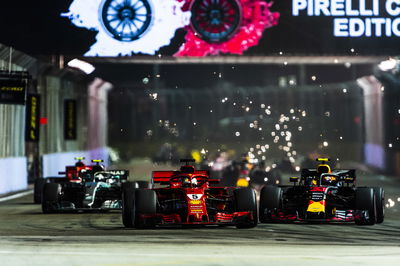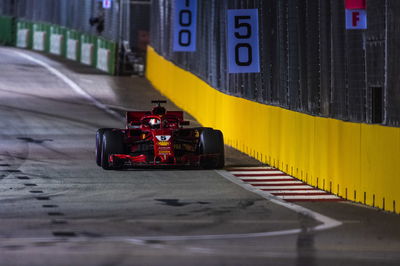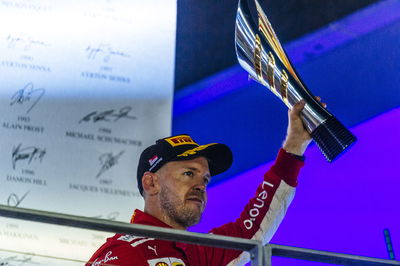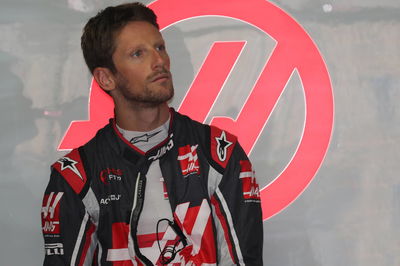F1 Race Analysis: Why Ferrari’s Singapore gamble backfired
Hindsight is a wonderful thing, but looking back on the 2017 season and Ferrari’s defeat to Mercedes in both Formula 1 championships, it is widely accepted that Singapore was the turning point.
A start-line crash eliminated title contender and pole sitter Sebastian Vettel from a race he was the heavy favourite to win, sparking Ferrari’s capitulation across the trio of Asian flyaway events that laid the foundations for Lewis Hamilton’s early championship win.

Hindsight is a wonderful thing, but looking back on the 2017 season and Ferrari’s defeat to Mercedes in both Formula 1 championships, it is widely accepted that Singapore was the turning point.
A start-line crash eliminated title contender and pole sitter Sebastian Vettel from a race he was the heavy favourite to win, sparking Ferrari’s capitulation across the trio of Asian flyaway events that laid the foundations for Lewis Hamilton’s early championship win.
While Vettel may have arrived in Singapore this year with a gap to Hamilton 10 times the size of that in 2017 (when he trailed by just three points, not 30), he was still expected to be the man to beat at Marina Bay. The gap may not be wiped away, but it would surely shrink.
And yet once again, Ferrari will be leaving Singapore licking its wounds after another opportunity was missed, with Hamilton capitalising to leave Vettel on the brink of losing control of his own destiny in the title race.
Boasting the fastest car on the grid and an enviable record in Singapore, Vettel was left bitterly disappointed with P3 in qualifying on Saturday. Hamilton’s pole lap may have been “magic”, stunning the F1 paddock, yet Vettel felt his effort was beatable. Indecision with the tyres in Q2 meant he didn’t have the race strategy he wanted, nor had he built up the rhythm to make an assault on the front row in Q3.
Vettel made a superb start, immediately pulling alongside Max Verstappen, but the brash Red Bull youngster wasn’t going to yield his position, immediately shutting the door on the Ferrari. Vettel tucked into his slipstream along the run to Turn 5, eventually getting ahead just before the Safety Car was called. Fears of a repeat of 2017 had been avoided by clearing the hurdle Verstappen represented, leaving only Hamilton ahead.
A straight fight between Hamilton and Vettel is something we’ve been wanting for a while, only to be left disappointed. Two Singapore specialists going head-to-head under the lights? It was the perfect setup.
Hamilton knows he doesn’t have the fastest car anymore, but track position is king in Singapore. Concerns about how long the Hypersofts would last led to suggestions the race could be similar to Monaco, where the drivers were going slowly enough to not ruin their tyres, thus keeping on a one-stop strategy. In the early stages of the race, that looked to be the case as Hamilton back up the pack, keeping his times around the mid-1m47s. Vettel was sitting a second back, unable to get close, with Verstappen a further second behind that.
Hamilton bolted on Lap 12. In the space of a single lap, he found 2.3 seconds, with the gap to Vettel growing to more than two seconds by the start of Lap 14. He’d radioed the Mercedes pit wall to say he felt his tyres still had a lot in them, something Ferrari misheard, telling Vettel that Hamilton was concerned he tyres did not have a lot left.

But the more crucial miscue from Ferrari would come one lap later. Fearing Hamilton may get out of reach, the team pitted Vettel to try and get the undercut - seemingly the only way he could win the race.
Vettel pitted at the end of Lap 14, taking on Ultrasoft tyres. It went against Pirelli’s recommendation, with the tyre supplier’s prediction being that all of the Hypersoft starters in the top 10 would have to go onto Softs if they wanted to do a one-stop. Ferrari’s plan was to always one-stop Vettel, though, believing the Ultrasofts were the better tyre, perhaps reasoning Vettel’s desire to use them for Q2 on Saturday.
Vettel managed to get out in clean air at first, emerging ahead of the gaggle of Romain Grosjean, Fernando Alonso, Carlos Sainz Jr. and Nico Hulkenberg, but he quickly caught onto the rear of Sergio Perez, who was eight seconds clear of Grosjean.
This is where Vettel’s race came undone. While he would not have caught Hamilton, the Briton having pitted one lap after Vettel to see off the undercut and returning to the track ahead before the Ferrari driver had got close to Perez, it was decisive in deciding the battle for P2.
Once Vettel overhauled Perez for fifth, he was almost five seconds back from Hamilton now, as well as seemingly requiring another pit stop. Verstappen, meanwhile, was continuing to push in the lead of the race, eventually diving into the pits at the end of Lap 17. Even with a slight stall when pulling out of his pit box due to the recurring engine issue, Verstappen still managed to snake out of the pits in front, squeezing Vettel to the outside at Turn 3 to seize the position. P2 was in the bag.
Verstappen wasted little time in getting his tyres up to temperature, allowing him to pull out a gap in no time to the struggling Vettel, who was already reporting that his tyres were fading. Vettel’s tyre advantage - which was anyway smaller than expected - was useless if he didn’t have track position to back it up.
It was there that P2 was lost for Ferrari. It had to go a different way on tyres to Mercedes if it wanted a shot at victory, but in trying to ensure Vettel had even a chance to jump Hamilton, the team pitted too early. One lap later, and he would likely have emerged ahead of Perez - and wouldn’t have lost out to Verstappen.
Alas, that is the beauty of hindsight. Post-race, Vettel was unwilling to point the finger at Ferrari, even if he had seen Hamilton finish almost 40 seconds up the road en route to extending his points lead to 40 as well.
“I will always defend the team. I think the decision we took in the race, the decisions to try to be aggressive, if it works, it’s great - today it didn't work,” Vettel said.
“Obviously it didn’t work by quite a bit, and we need to look into that. But I believe we saw something, and that’s why we go for it. Obviously inside the car it’s difficult to be on top of everything because you cannot see where you come out etc. We were aggressive in trying to get ahead, taking into account that we have to go through traffic, which in the end bit us also, to lose the second place.
“If it doesn’t work, it is always easy to criticise. But I will always defend what we did.”

Vettel was perhaps fortunate that Valtteri Bottas in P4 was also struggling with his tyres, given his times dipped in the closing stages. Despite his fears the Ultrasofts would not make it to the end, they did, albeit finishing with a string of laps in the 1m45s and 1m46s - Hamilton and Verstappen were both in the 1m43s at that point. It was a bold strategy call, but one that did not play out.
For the fourth time in five races, Ferrari will be leaving on Sunday night wondering how it did not win. It was fast in practice, looked strong on paper - and yet Mercedes (and, more concerningly, Hamilton) snatched victory away.
It’s a worrying trend Ferrari must stop - and soon. Even if Vettel were to win all of the six remaining races, if Hamilton finished second each time, the Ferrari driver would only win the championship by two points. He is barely clinging on to controlling his own destiny in the title race.
As for Hamilton and Mercedes? They will once again be revelling in another stunning and unexpected victory, only adding to the feeling that if the team were to make it five straight sets of championships this year, they would be the greatest so far.











